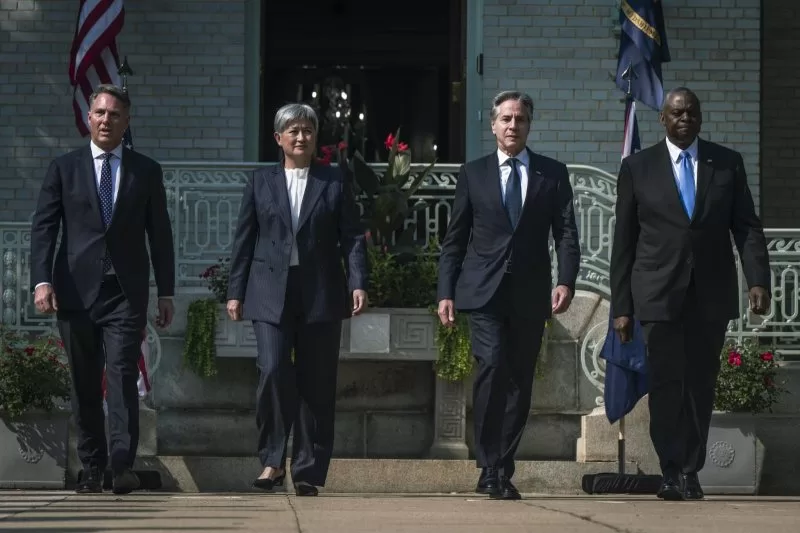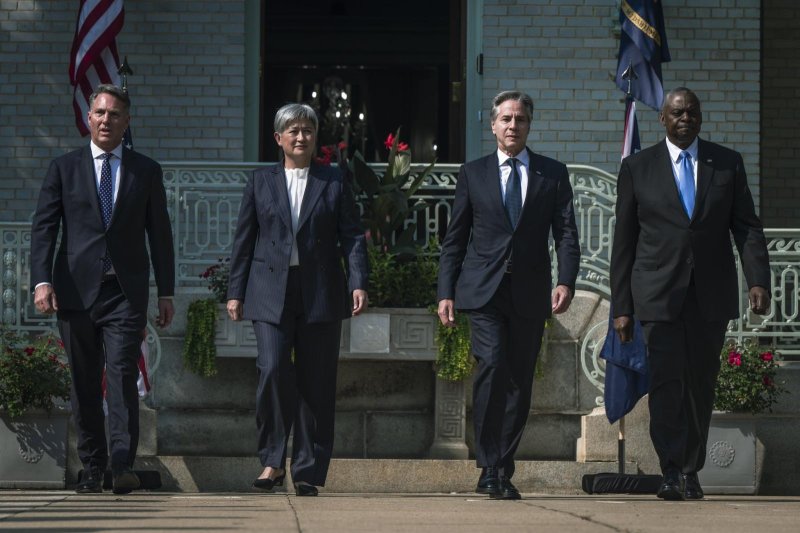From left, U.S. Secretary of State Antony Blinken, Foreign Minister Penny Wong of Australia, Defense Minister Richard Marles of Australia and U.S. Defense Secretary Lloyd Austin. The four leaders met Tuesday in Annapolis, Md., for bilateral conversations on military posture and other joint areas of collaboration. Photo courtesy of Defense Secretary Lloyd Austin/
XAug. 6 (UPI) — The United States and Australia took steps Tuesday to deepen their relationship, primarily militarily, as the Biden administration has sought to bolster ties with allies in the Indo-Pacific amid growing global competition with China.
U.S. Secretary of Defense Lloyd Austin and Secretary of State Antony Blinken hosted their Australian counterparts for the 34th Australia-U.S. Ministerial Consultations in Annapolis, Md.
A joint statement following the meeting states there was a recommitment to “promoting a prosperous and peaceful” Indo-Pacific region from the United States and Australia, with both highlighting actions they have taken to deepen their military ties since President Joe Biden hosted Prime Minister Anthony Albanese for a state dinner in October.
During a press conference, Austin said they continue to deepen their force posture cooperation that includes upgrading air bases, operating from new locations and establishing a new logistic location all on the Oceanic island nation.
“We’re also increasing the presence of rotational U.S. forces in Australia, and all this will mean more maritime patrol aircraft and reconnaissance aircraft operating from bases across northern Australia,” he said.
“It will also mean more frequent rotational bomber deployments.”
Austin announced a “doubling down” of the United States’ defense industrial base cooperation that will see by the end of the year two agreements signed between the countries: one for the manufacturing of Guided Multiple Launch Rocket Systems in Australia by 2025 and the other concerning the co-production, co-sustainment and co-development of a Precision Strike Missile in the country.
“American force posture now in Australia involves every domain: land, sea, air, cyber and space,” Deputy Prime Minister and Minister of Defense Richard Marles said, as he explained the presence of the U.S. forces in Australia provides them “an enormous opportunity” to work with regional partners, such as Japan, another country that the Biden administration has worked to foster closer military ties to.
Though China was rarely mentioned, it loomed over the meeting as the Asian nation has provided democracies with the greatest challenge in the region. Its growing assertiveness that has resulted in skirmishes with neighbors, in particular the Philippines, has been a cause for concern, as is Beijing’s determination to reclaim Taiwan — a self-governing democratic island — by force if necessary.
Australia’s foreign minister, Penny Wong, explained their discussions Tuesday surrounded working together to ensure the Indo-Pacific is peaceful, open and prosperous, adding their discussions are “an investment in the protection of democracy.”
Blinken said through the meeting, they discussed threats to their shared vision for the region and agreed upon the importance “of maintaining peace and stability in the South China Seas, the East China Seas, and countering any attempts at coercion.”
“We’re united on the need to maintain peace and stability across the Taiwan Strait and to resist any actions that escalate tensions or undermine the status quo,” he said.

